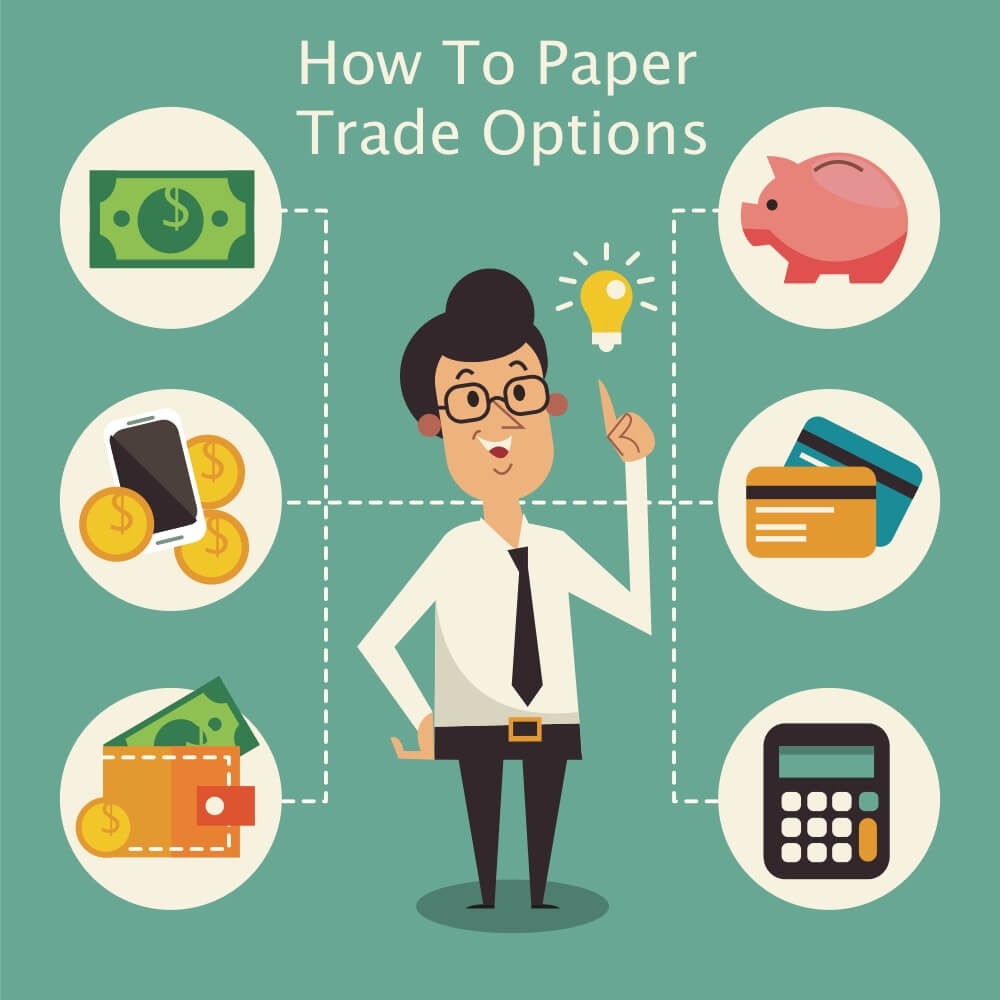Investing comes with risks, that’s a fact of life. Generally speaking, the greater the risks, the greater the potential for profits. In these regards, options trading offers a high potential for profits, but does come with some higher risks. This is especially true for newer investors. Experienced and/or well-educated options traders, however, can utilize a variety of strategies to lower risks. For newer investors, paper trading options is a great way to get started.

Given all of the risks associated with investing, it’s important for investors to pay close attention to what they are doing, to be conscious of risks, and to constantly stay up to date on the market. For investors who are new to the game, one great way to get started is with “paper trading”, which refers to simulated investing with fake money. Paper trading is especially great for traditional investors who want to learn about options trading.
A variety of stock brokers and other organizations now provide a variety of trading simulation tools and paper trading options. These tools allow you to execute trades based on up-to-date market data, but instead of risking real money, you use fake money. You can then monitor your performance based on real-world market data. In other words, paper trading is very similar to actual investing, but you don’t have to risk your money.
Where Can I Find an Options Paper Trading System?
There are many great paper trading options and simulators available on the Internet. Some of them specialize in certain assets, such as futures or options. Others allow you to trade a variety of assets. Let’s briefly highlight some of the more popular paper trading platforms:
Investopedia- this popular investing education platform also offers a great paper trading platform. You can paper trade stocks, options, and other assets on Investopedia, making a great choice for people who want to try various investments.
OptionsXpress- this website offers a great platform for paper trading options. You start out with $25,000 dollars in fake money, and can start trading right away.
MarketWatch- features a bare bones and perhaps difficult to use interface. However, their Virtual Stock Exchange simulator offers great opportunities for paper options trading.
There are many other stock and option simulators out there. If none of the above suit your fancy, go ahead and search around for other options. So long as the paper trading system allows you to make a variety of trades and is based on real-time information, you’ll be afforded plenty of opportunities to learn.
Who Should Use Paper Trading and Why?
Paper trading is a fantastic choice for people who are new to investing, or are trying out a new type of investment vehicle, such as options. For example, if you’ve been steadily building up your retirement and stock portfolio, and want to expand into options, starting with paper trading makes a lot of sense. You’ll be able to learn how investing works and can also tinker with various strategies. While reading blog posts from thought leaders like Tasty Trade is a great way to increase your investing knowledge and skill, at the end of the day experience is also essential.
Quite simply, picking up knowledge is one thing, while implementing it is another. There are tons of fantastic option trading strategies that can help traders reduce risk and increase the potential for profits. Options Cafe and other websites work hard to provide as many insights and opportunities as possible. Yet at the end of the day, you as an investor must put that knowledge to work. You have to conduct the trades and you have to manage your portfolio. Paper trading offers a great way to test theories and learn the ropes, while not exposing yourself to unnecessary risks.

Paper trading is especially important for options because premiums, fees, and time decay will all play a big role in your investment strategies and will impact your profits or losses. With stocks, many trading strategies allow you to simply focus on price. With options, there are more considerations that you have to pay close attention to. Paper trading options will help you learn how to focus on these different aspects and variables.
However, there are some downsides to paper investing. Most importantly, it’s simply not real. Even if you start making a lot of “money” off of paper trading, you’re not really making any profit at all. Further, many traders do great with paper trading because they are unencumbered by fear. Without real money at stake, investing can be a relaxing and feel more like a video game rather than wealth management. Making big, bold trades is easy, and often those bold moves will produce big “profits.” Once real money comes into play, however, many investors tighten up, and their trading strategies change, even if subconsciously, and often for the worse.
Let’s jump into how you can properly utilize paper trading options, while also digging deeper into the limitations of simulations and how you can overcome them without exposing yourself to too much risk.
Putting Paper Trading To The Best Use
Not ready to jump into options trading with live money? That’s okay. Paper trading options offers an excellent way to get started. With paper trading, markets are live but the money you invest isn’t. This means that the simulations are highly accurate and will reflect real world conditions.
When you invest the fake dollars, treat it like a real trade. If you’re a risk averse trader, then you should focus on making paper trades that mitigate risks. If you’re willing to expose yourself to more risk, go ahead and do so. Just make sure you’re being honest.
Of course, with paper trading you can also test new ideas, higher risk trades, etc. in order to learn new strategies. You might be intimidated by the risks involved with options trading, but after paper trading you might quickly find that you actually have a knack for it. The same is true of individual strategies. Some options trading strategies are much lower in risk, but generally have restrained profit potential. Other strategies offer great profit potential, but also carry higher risks.
In order to learn, it’s important to think through each trade. Why are you buying an option for this stock? How can you use an iron condor in that market? Don’t just throw darts at the wall and hope that your trades bear fruit. Be strategic. As you conduct paper trades with options, some of them will undoubtedly turn sour. Don’t get discouraged, take it as an opportunity to learn! Sit down and try to figure out why that particular options trade didn’t turn out well.
While paper trading options offers a great way to get started and to learn, nothing beats real, live experience. Of course, investing can be intimidating. With opportunities come risks, and it is possible that you will lose some money. This is true of any investment vehicle, including stocks, bonds, futures, Forex, options, and all the rest. Options tend to have a higher risk profile, but also a higher profit potential. Further, various options strategies can be used to mitigate risks.
Regardless, many investors get nervous when they start options investing. The transition from paper trading to real-live options investing is often bumpy for investors. Yet if you’re serious about making money, you have to get serious about investing real money. That’s why Options Cafe recommends transitioning from paper trading to real trading as soon as you’re comfortable with both options trading basics and the options strategies you plan on utilizing.
Before betting the house, however, we recommend that you start with a smaller amount of “risk capital”. Let’s jump into what that means.
Start Options Trading With a Small Amount
Don’t want to risk your retirement portfolio with options trading? That’s a wise idea. While options trading has a fantastic potential to produce profits, there is a risk of losing money as well. If you’ve learned all that you can learn from paper trading options and are ready to jump into options trading, it’s smart to start investing with a smaller amount, say $2,000 dollars.
This way, you will limit your exposure. Yes, you’ll also limit your profit potential, but that’s okay for newer investors. Obviously, no one wants to lose or even risk $2,000 dollars if they don’t have to. However, you can think of this initial investment as an educational opportunity as well (more on that later).

When you first start investing in options, you should limit yourself to “risk” capital. This refers to money you can afford to lose. No one wants to lose money, of course, but many people can afford to lose a certain amount before it starts to really affect their life style.
For example, you might start by trading with $2,000 dollars. When it comes to options trading, fees, commissions, and all the rest mean that you will generally produce limited profits with only $2,000 dollars invested. However, by limiting your exposure, you won’t be putting yourself at serious risk.
Even if the nearly inconceivable happens and you lose all $2,000 dollars of your investment, you likely won’t lose your home or vehicle. Yet by investing with real money, even a small amount, you’ll start to see how you react to the pressures of a live market and live risks. Often, you will find your reactions to be different from when you were paper trading options. This is normal, but do take note.
If your trading is detrimentally impacted, which quite frankly is common, you need to sit down and take a deep breath. What strategies produced results when you were paper trading options? How can you implement them now? Remember, you’re only trading risk capital, so it’s okay to take some risks.
On the other hand, it’s usually a bad idea to overexpose yourself when you are just beginning to trade options. Even if you’ve enjoyed a ton of success with paper options trading, it’s not a good idea to jump in with large investments right away. By easing in, you’ll reduce risks and set yourself up for a higher chance of long-term success.
The Best Platforms for Small-Capital Options Investing
So you’re ready to invest some risk capital in options trading. You’ve already managed an account on Investopedia or another options paper trading simulator. Now you want to jump in. Which options broker should you use? There are tons of options brokers, and many of them have their own unique advantages and disadvantages.
We don’t want to discourage you from shopping around for an options broker, but in our experience Tastyworks.com is the best broker for newer investors who are trading with smaller amounts. They are great for options trading with large amounts as well, but when it comes to limited capital investing few platforms offer as competitive of fees and commissions.
Newer Investors Should Think of Their Investing as an Educational Experience
There’s no getting around it: when you start investing in options there is a risk that you will lose some money. It’s possible, even if unlikely, that you could lose all $2,000 dollars or whatever your initial investment is. Don’t let that intimidate you, and remember that even Warren Buffet and other world-class investors make bad investments from time to time.
Further, every time you invest you are creating an opportunity to learn. There’s an old saying, “practice makes perfect”, and that’s true for investors as well. Every time you invest, you are creating an opportunity to learn, and as you learn you can improve. People always say education is invaluable, and that’s true. However, we can put some hard numbers to it as well.
Think about how much tuition at a university is. In-state tuition at many public tuitions is now above $15,000 dollars per year. Private schools (many of which have the best investing and finance programs) can top $40,000 dollars per year! Each year, hundreds of thousands of students and their families fork over their savings accounts for education. In the long run, however, it’s usually worth it. A bachelor’s degree along can equate to $2.3 million dollars or more in lifetime earnings, on average, over a high school only degree.
In that context, options investing is actually quite cheap, and the education can be just as valuable, and for some options traders, even more so. Of course, paper trading options is free, so even if you’re a bit skeptical, give it a shot. There’s no risks. Having trouble producing profits? Recalibrate your trading strategies. With time, effort, and patience, you’ll all quite likely start producing profits.


